Note: Originally this post was planned as a series of posts. I changed my mind since referencing back to a series of posts can be problematic for finding the desired content. The table of contents was created to help skip to information of interest.
Table of contents
Background:
My GTI was purchased used and the prior owner had installed a Forge Blow Off Valve (BOV). On previous turbocharged cars I’ve had both stock diverter valves (DV) as well as aftermarket BOV. In each case they performed as expected so I didn’t think twice about having the Forge BOV on the GTI.
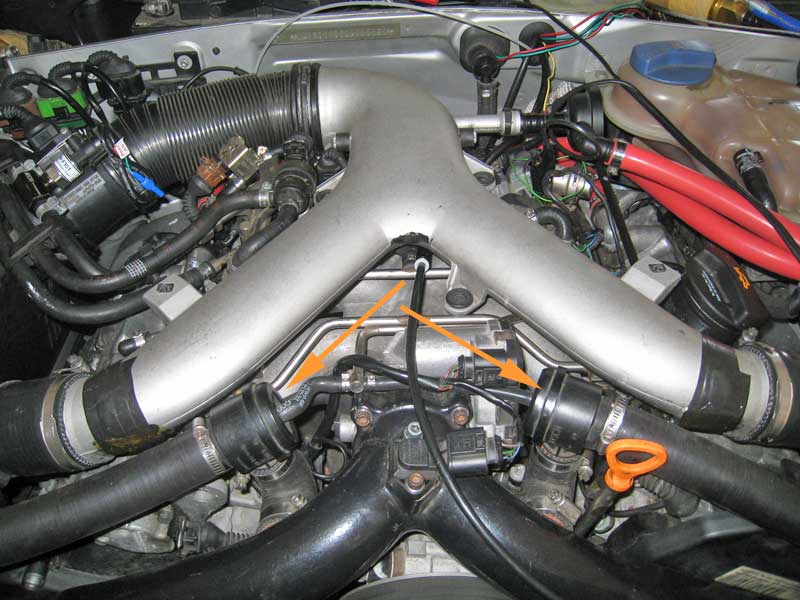
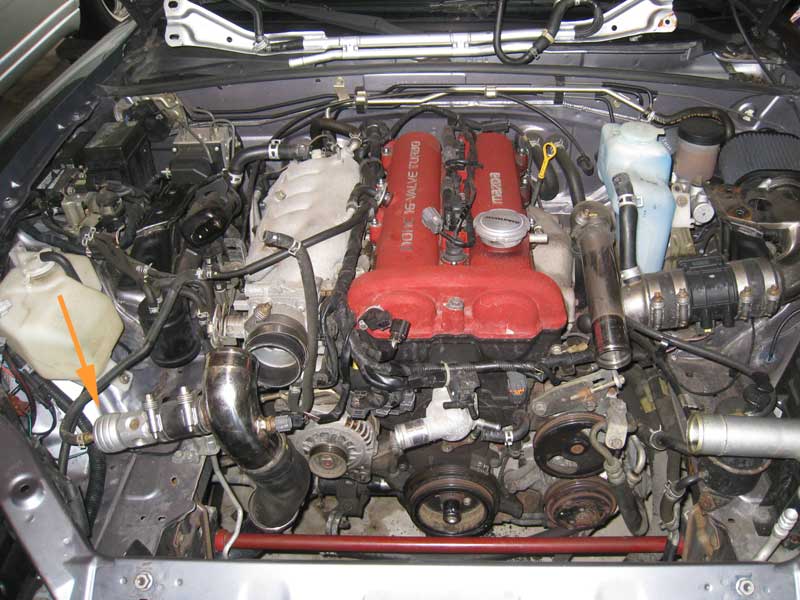
What others say
After reading discussions about modifications to the GTI I came across a number of recommendations to avoid using a BOV and stick with the stock DV.
Some of these from the GolfMk7 forum are shown below, though this collection is just a very small sampling and I have seen the same advice regularly given on Facebook posts.
- “Everything works better with the stock DV – no spacer. Stock is best.”
- “stick with stock….ran a spacer…forge BOV…turbosmart Plump….all ran like crap and the car lost power.”
- “The stock DV is the best one.”
- “Stock is best.”
- “The stock DV is the best you can get for a mk7….literally anything else is a downgrade and waste of money.”
Bypass valve operation
Briefly reviewing the purpose of the “bypass valve” aka BOV or DV, both function to decrease air pressure in the passageway between the turbo compressor outlet and throttle body in response to the throttle body closing. The “bypass valve” opens to prevent the high pressure air from producing pressure fluctuations that could damage the compressor blades or bearings.
As shown in the diagram below, when the “bypass valve” opens the pressurized air in the system is able to travel into the air intake passageway between the air filter and turbocharger compressor. The BOV will vent the pressurized air directly to the atmosphere instead of into the intake as the DV does.

Systems under test
Bypass valves that I have available at the start of this test are a stock Diverter Valve manufactured by Pierberg, and a blow off valve manufactured by Forge Motorsport.

The stock DV is well described in this post by Stratified Automotive Controls that also shows the evolution of the OEM design.
The Forge BOV is electronically controlled like the OEM DV, but differs in that a valve pneumatically enables the piston to open and close, versus the OEM DV using an electronic solenoid.
Other options are:
- Turbosmart DV or BOV – Electronically controlled and actuated.
- Spulen BOV – Pneumatically controlled and actuated.
- CTS Turbo BOV – Electronically controlled and pneumatically actuated.
Determining test conditions
Having read the cautions that the BOV installed on my GTI might lead to issues I set out to learn what problems the BOV causes, and what to be looking for in my data logs to spot the problems.
Note: Given the multiple control strategies employed by the aftermarket bypass valves generalizing issues as “affecting BOVs” is not being specific enough, issues ought to be associated with the control type, and perhaps even the specific brand / model.
First it was necessary to establish the operating conditions under which the BOV causes problems. Since the bypass valve opens when the throttle plate closes the conditions of interest are when the turbocharger has created boost pressure and the throttle plate is closing. Two situations I can think of when the throttle plate would be closing rapidly are letting off the accelerator pedal to slow down, and to shift gears when operating a manual transmission.
In my case I have a DSG equipped GTI and so a question is, will the throttle plate close and bypass valve open when the DSG shifts, similar to the manual transmission? This question had come up in a discussion I read and there were conflicting views:
“The DSG shifts too fast for that to be a problem.”
“Negative. It’s still a thing.”
-GolfMk7.com
No data was presented in the discussion on the forum to support either position so I found a log of a multiple gear pull to evaluate:

The green line, TPS, is the throttle position sensor. This value will decrease when the throttle closes, which is when the bypass valve will open. As shown by the red Gear line, the DSG shifts between multiple gears and the throttle position is unchanged until the accelerator pedal position decreases at time 12 seconds. Once the accelerator pedal drops to zero the throttle plate follows momentarily thereafter.
First Conclusion:
A claim that the BOV causes issues during shifts with a DSG is not supported by data. This is because the throttle does not close during DSG shifts therefore the bypass valve will not open.
Determining Test Conditions (Continued)
For the sake of gathering data I need to simulate a gearshift condition. To do this the transmission is set into manual mode so that the TCU does not shift gears. The accelerator is fully depressed to go wide-open-throttle and once boost pressure has built up the accelerator is released to return to zero percent (0%), and momentarily thereafter the accelerator is quickly depressed, to mimic a gear shift using a manual transmission.
As shown in the comparison charts below, this method does a good job of approximating the accelerator movement during a manual transmission gear shift.
The other situation that produces an opening of the bypass valve is lifting off the accelerator to slow down. Slowing down doesn’t seem like a particularly interesting condition to be investigating how the bypass valve affects the engine operation, but it will be evaluated.
A third and fourth condition were brought to my attention as possibilities, when Traction Control is active, and at part throttle.
Researching why stock is best and the BOV is bad
In looking for reasons as to why the BOV is not recommended I came across some interesting explanations.
Right out of the gate I was confronted with a claim that the DV and BOV don’t even serve the same purpose:

This next explanation for why you should avoid using a BOV is so entertaining that the whole explanation is worth repeating:
“i had the cts bov for a while and it was fun, but i started to notice, especially after tuning, a little loss in power or response, idk never looked at numbers, but for sure there was a loss somewhere. I went back to stock and it was night and day, the shifts and and revs were way more responsive. My friends were like no shit your releasing pressure instead of keeping it on high revs blah blah, idk the science but i def prefer stock and constant pressure vs just sound and lack of response. shop workers also gave me the same info that bov’s are a waste, sound is cool but when you wanna go fast you are sacrificing the pressure you just finished building prior to shifting. Recyclation air pressure vs having to rebuild it. again i don’t know shit to it just stating what others have said.” (GolfMk7.com)
This stuff kills me, paraphrasing: “I didn’t look at any data, I don’t know how this stuff works, I don’t know shit, but for sure there was a loss somewhere.”
To evaluate data to compare against claims I need a list of issues to look for with the BOV. Starting with the above explanation, the BOV causes:
- Loss of power
- Loss of response
- Sacrificing pressure that just finished building
A common theme I came across in many comments is about how the diverted air, recirculating back into the intake by the DV, helps to maintain boost pressure during a shift. This misunderstanding has been around for along time:

There are some elaborate explanations of this “issue”:

Trying to lead some people to a better understanding of what is actually happening was seldom successful:

I never did get the basic physics explanation.
Recycling vs Fresh Air
What these commenters are not accounting for is that the diverter valve effectively vents to the atmosphere the same as the BOV does. The area in front of the compressor wheel is open to the atmosphere, albeit after going “out” the intake.
The compressor inducer is an area of lower pressure, but only until the discharged air from the DV raises the pre-compressor pressure to atmospheric pressure. With the throttle plate closed and turbo slowing down there is little demand for air by the compressor wheel.
The air intake is not a closed container, if pressurized air enters the intake pre-turbo there is nothing preventing it from going out the intake the opposite direction the turbo has been pulling air in from. The only reason air moves through an intake is because the compressor blades create a low pressure region at the inlet of the compressor housing.
The list now includes:
- Loss of power
- Loss of response
- Sacrificing pressure that just finished building
- Have to build up pressure after BOV closes
- DV loses almost no boost on shifts.
- BOV leads to sharper RPM drop off and boost drop at shifts
What to log?
Since the purpose of the bypass valve is to relieve the pressure that has built up in the charge pipes a logical variable to record is the air pressure in those pipes. Pressure Upstream of the Throttle (PUT) and the Manifold Air Pressure (Boost) are two candidates.
Which pressure sensor to log? Do I use the MAP sensor data or PUT sensor data? Log both and compare to see if one would be better than the other was the decision. As the side-by-side charts of the readings below show, once the PUT values are shifted by a constant value of -14.6 the curves are identical (right side chart).
Since there is no significant difference in the readings produced from each of the sensors I am going to use Boost pressure for my analysis.
Note: It was pointed out to me that the Boost Pressure reported by the Cobb Accessport is calculated from the PUT sensor reading. Well, that explains the uncanny similarity in the curves. Thanks for insight Ed from Equilibrium Tuning!
More researching of online discussions about the two products uncovered some candidate variables to record.

This statement contains a double dose of misinformation. 1) The ECU doesn’t meter any air until it is past the throttle, that’s what the TMAP (Temperature / Manifold Pressure Sensor) on top of the intake manifold does. 2) This explanation is based on the “recycled’ vs “fresh” air misunderstanding that was addressed above. Logging AFR is easy enough so for completeness I’ll add it to the variables to be recorded.
“log your fuel trims after upshifting. You’ll notice they’re gonna be loose. You should also notice a loss of acceleration after an upshift. I’m referring to a bov the vents to atmosphere“
This would be a result of issues with the AFR, unlikely, but STFT and LTFT will be logged as well. Measuring acceleration is tricky and would need to change significantly to be noticed. The Cobb Accessport can log the vehicle speed with time stamps, from which acceleration can be calculated.
“you can log the boost pressure, wastegate duty cycle, and possibly the recirc valve (DV) voltage/position.“
The WGDC and Recirculation valve position will be good to record.
“The problem isn’t necessary designs leaking, it is the fact that the mk7 DV is perfect. It holds very high boost, it dumps when it needs to and it does it very, very fast. When you start putting in spring controlled DVs and spacers, what happens is the ECU can not accurately pulse/read the DV to create boost + load targets. This will inevitably cause power LOSS. Even if some claim that “it doesn’t happen for me,” 9/10 they aren’t logging these engine parameters because if you did, you would go back to stock.”
Adding Driver Requested Torque and Torque Actual to the list.
A couple additional variables that I’ll be logging are the Recirculation Actuator Set Point, Accelerator Pedal Position, and Throttle Plate Position.
The list of variables to log is:
- Accelerator Pedal Position
- Air-Fuel Ratio
- Boost Pressure
- Driver Requested Torque
- Long Term Fuel Trim
- Recirculation Actuator Position
- Recirculation Actuator Set Point
- Short Term Fuel Trim
- Torque Actual
- Throttle Plate Position
- Vehicle Speed
- Wastegate Duty Cycle (Turbine Actuator Final Value)
- Time
What to look out for?
Cataloging the issues to be on the look for. These include:
- Loss of power
- Loss of response
- Sacrificing pressure that just finished building
- Have to build up pressure after BOV closes
- DV loses almost no boost on shifts.
- BOV leads to sharper RPM drop off and boost drop at shifts
- Air-Fuel ratio “anomalies”
- STFT / LTFT “anomalies”
- Loss of acceleration
- Incorrect load targets
Note: Over the course of a few months I copied statements provided by multiple “enthusiasts” concerning what’s wrong with BOVs, what problems they cause, and why. When I would ask for data logs of the issues being described the responses were unanimously like these examples:
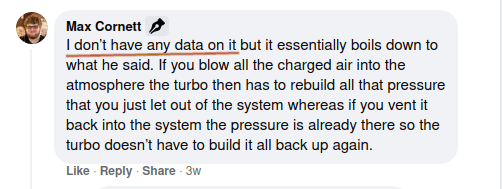


Only once did an explanation of poor BOV performance include data logs to provide evidence to support the statements being made. In this one case where data was available the person had failed to log the throttle position or recirculation valve position and the data showed the wastegate failing to close.
Show me the data
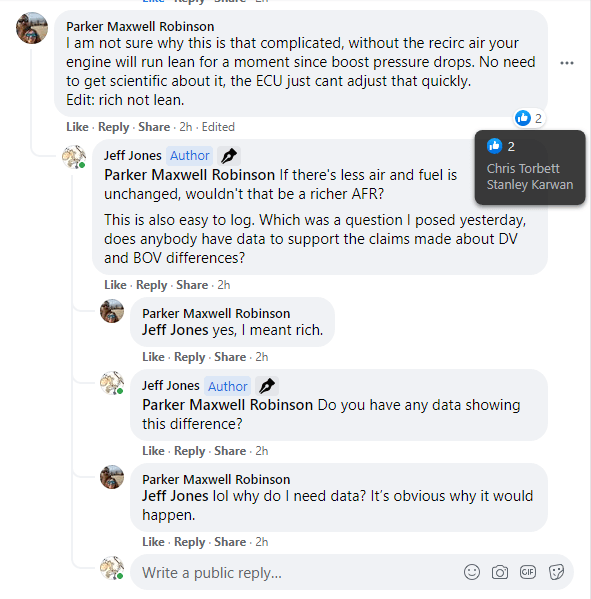
The last comment is a favorite:
“lol why do I need data? It’s obvious why it would happen.“
To collect data for comparison each product was installed on my GTI and I operated the car in third gear. The car was accelerated at wide open throttle and once boost pressure built the accelerator pedal was fully lifted and then momentarily after fully depressed. This was repeated several times with each recirculation valve installed.
Onto looking at some data.
Enthusiast issue #10 Incorrect load targets
Here’s a comparison of the Driver Requested Torque and Actual Torque which is what the ECU calculates to be current torque output.

Requested torque and actual torque curves are nearly identical for the DV and BOV.
Ironically the enthusiast quoted above who references logging engine parameters failed to do so to support their argument. I didn’t find any data showing the ECU couldn’t hit target values when using the Forge BOV.
Next is a chart showing the Air-to-Fuel ratio. (#7 – Air-Fuel ratio “anomalies”)
Based upon enthusiast statements there should be a rich spike after letting up on the accelerator with the BOV:

In both the BOV and DV case the Air-to-Fuel ratio goes lean shortly after letting off the accelerator. As was pointed out in the Recycle vs Fresh section, the idea that venting to atmosphere (VTA) changes the conditions before the turbo differently from the Diverter Valve is incorrect.
Enthusiast issue #8 STFT / LTFT “anomalies” – Based on the fact that the AFR anomalies do not exist as claimed, the likelihood that there are STFT and LTFT anomalies is nil.
It’s hard to detect a trend when mashing the pedal, lifting off, mashing it again, and repeating that sequence three to four times in a row with varying times of no pedal input. Overall nothing stands out, both STFT and LTFT move around and LTFT tracks roughly between 0-5 for both products. Bear in mind the only time the DV/BOV is functioning is when the blue lines spike upward.
Enthusiast issues #5 DV loses almost no boost on shifts and #6 BOV leads to sharper RPM drop off and boost drop at shifts.
Looking at the RPM decrease during a shift, when the accelerator is lifted and the throttle plate closes is not useful if the boost pressure does not behave as claimed, so boost pressure is checked first.
The rate of boost pressure decrease is measured after the Recirculation Actuator goes to 100%. The actuator going to 100% is an indication the ECU is commanding the valve to dump boost pressure.
Note: The Recirculation valve is effectively an on/off switch functioning primarily at 100% or 0% with brief moments of transition between open and closed. During one session there were 60,464 data points at 0-1%, 2191 data points at 99-100%, and 81 data points in between 1% and 99%.
The next chart shows the typical activity of the recirculation valve.

Once the recirculation actuator goes to 100% the time for the boost to drop to 10 psi is noted. The curves of boost pressure drop for the stock DV (blue lines) and Forge BOV (orange lines) are shown on the chart.

Issue # 5 and # 6 are disproven. The opposite of what was claimed is observed in the data, the stock DV drops pressure faster than the BOV and both devices do what they are supposed to, reduce boost pressure when the throttle is lifted.
This chart is worth further examination. How much “faster” is the stock DV than the Forge BOV? Not much.
On the left is a boxplot of the time data for each product to reach 10 psi after the recirculation valve is commanded to 100%. The shorter time of the stock DV is apparent from the absence of overlap in the boxes.
On the right is a t-test using these data points assuming unequal variances and a null hypothesis that the means are equal. The sampling of data does not support the hypothesis that the products perform equivalently on this measure.
The stock DV reaches ten psi 8/100ths of a second faster than the Forge BOV.
Second Conclusion:
The stock DV drops boost pressure more rapidly from a fully boosted state to ten psi than the Forge BOV. The difference is 8/100ths of a second.
Dirt Road

Skip to the next section if you aren’t interested in cool science shit, this was an interesting dirt road to go down.
Seeing the boost drop time results started me wondering what affect the Forge BOV hoses might be having on the response time. I skimmed through a few research articles on pneumatic brake lines used on vehicles and found that yes, the length of the line could affect the response time.
The Forge BOV lines are relatively short to begin with, nothing like a truck trailer or bus brake lines, but this was an evaluation that was differentiating products that have eight one hundredths of a second difference in response time. How about modifying the hoses of the Forge BOV and see what the results are?
At the time of the data collection I was using an APR boost tap that is fixed to the side of the intake manifold. A boost/vacuum line goes through the firewall to an Autometer boost gauge inside the cabin and has a tee part way along the line that is supplying vacuum to the BOV.

I decided I would shorten the vacuum hoses as much as practicable and connect the BOV to the vacuum source at the back of the intake manifold near where the DV/BOV mounts on the turbo. This Deutsche Auto Parts video does an excellent job of showing this connection location.
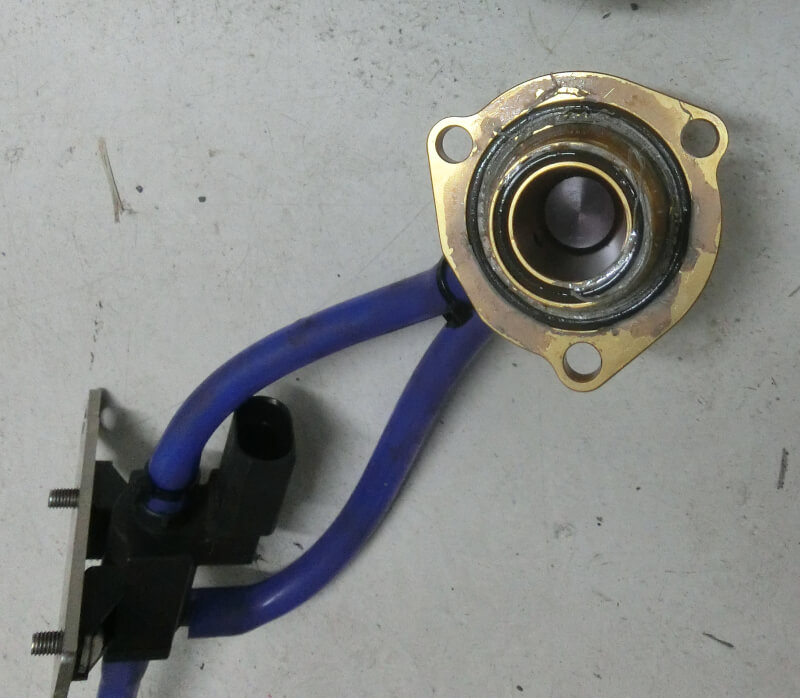
With the Forge “Short Hose” (SH) variant installed I went and performed more data logging.
A subset of the Short Hose data is shown in the chart (green lines), I didn’t include all of the data lines as the chart gets messy and it’s hard to pick out the differences. Most notable is that boost does not increase during the first fraction of a second.
The initial rise of the standard length hose is likely due to a slightly longer response time allowing the pressure to build slightly and then dropping.
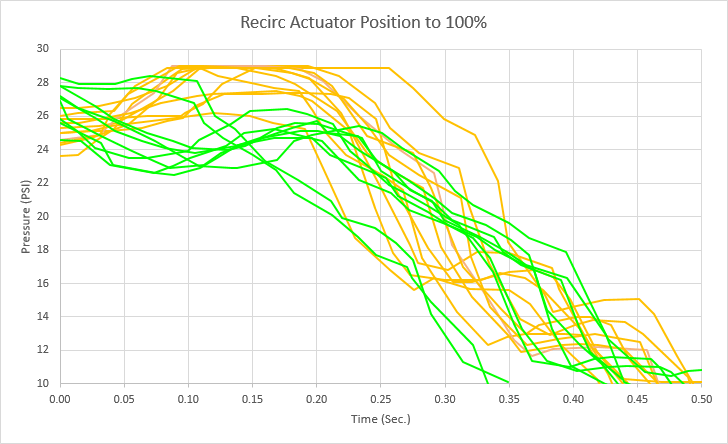
There’s a decent amount of variation in the data, but looking at the box plot on the left, and the results of the t-test on the right, both show that the reduction in the hose length did have a statistically significant affect on the pressure drop time.
Cool stuff! I was not expecting the reduction in hose length to make a difference.
Going back and looking at how the shortened hose BOV compares with the stock DV there is a fair amount of overlap in the data as shown by the box plot.
The t-test confirms that there is still a statistically significant difference in the data sets indicating the stock DV reaches 10 psi faster than the modified Forge BOV.
Note: The time difference between the stock DV and Forge BOV was reduced 52% by the shortening of the hoses from 0.080 seconds to 0.039 seconds. Also, if the t-test is run at a 99% confidence level the hypothesis that there is no significant difference in times can no longer be rejected as it is at the 95% confidence level. Bottom line, there’s only a very small difference between the sample data generated by each product during this phase of the test.
Returning to investigating issues:
Here is where things stand with the issues list:
- Loss of power
- Loss of response
- Sacrificing pressure that just finished building
- Have to build up pressure after BOV closes
- DV loses almost no boost on shifts. (Disproven)
- BOV leads to sharper RPM drop off and boost drop at shifts (Disproven)
- Air-Fuel ratio “anomalies (Disproven)
- “STFT / LTFT “anomalies (Disproven)
- “Loss of acceleration
- Incorrect load targets (Disproven)
The next activity to evaluate is:
After lifting off the accelerator pedal the next action is to depress the pedal to the floor again. This will open the throttle plate and should close the recirculation valve, as well as closing the turbine wastegate so the turbo can begin to speed up. Boost pressure should stop dropping at this point.
For the next evaluation the time is measured from when the recirculation actuator position goes to 0%, indicating the ECU has commanded the bypass valve to close, to the time that the boost pressure stops decreasing.
The box plot shows the data overlaps indicating the times are similar. The t-test confirms the times are very close. Although the Forge BOV has an average time that is slightly faster than the stock DV, there is enough variation in the data that there is not strong evidence to conclude the BOV is faster.
The products perform the same on this measure.
The next comparison is an expansion of the previous test with a difference being that once the accelerator goes to 100% and the actuator position goes to 0% the time it takes for boost to build to 20 psi is evaluated.
This measure is more difficult to evaluate because when the accelerator pedal is fully depressed, which is when the timing begins, the current boost pressure could potentially be anywhere between zero and maximum boost, 0-28 psi. The amount of time for boost to build to 20 psi is a function of the starting boost level, which was not something I could easily control.
Theoretically if enough data was recorded there would be random instances of overlap between the two products, and those overlaps could be analyzed. My guess is that the process of accelerating full throttle would have to be repeated several hundred times to produce enough overlap for a statistical analysis.
Unwilling to put in that level of effort the data is plotted on a chart to make a visual comparison.

The time for boost to build to 20 psi is approximately the same for the DV and BOV. There is no clear breakout between the data sets.
These previous two checks are used to evaluate enthusiast issue #3 Sacrificing pressure that just finished building and #4 Have to build up pressure after BOV closes.
Issue #3 is related to the “recycle” vs “fresh” misunderstanding and additionally there is no evidence from the data showing that pressure is sacrificed by the BOV.
Issue #4 is clearly incorrect, both the DV and BOV produce a pressure drop and both need to build up pressure again. The last two tests show that the time to build up that pressure is very similar between the products with no clear advantage for either DV or BOV.
A late entry potential issue has to do with the BOV possibly sticking if traction control activates.
“tendency to stick open when the ECU quickly pulses the valve open/closed without closing the throttle. This condition can happen with traction control intervention or sometimes with slight part throttle pedal modulation.”
My GTI has encountered traction control activation frequently during the Stratified E30 tuning effort and to my knowledge the BOV never got stuck. I haven’t seen a data log showing the boost falling when it was not expected to.
The chart below shows throttle cut occurring and the BOV functioning as expected.
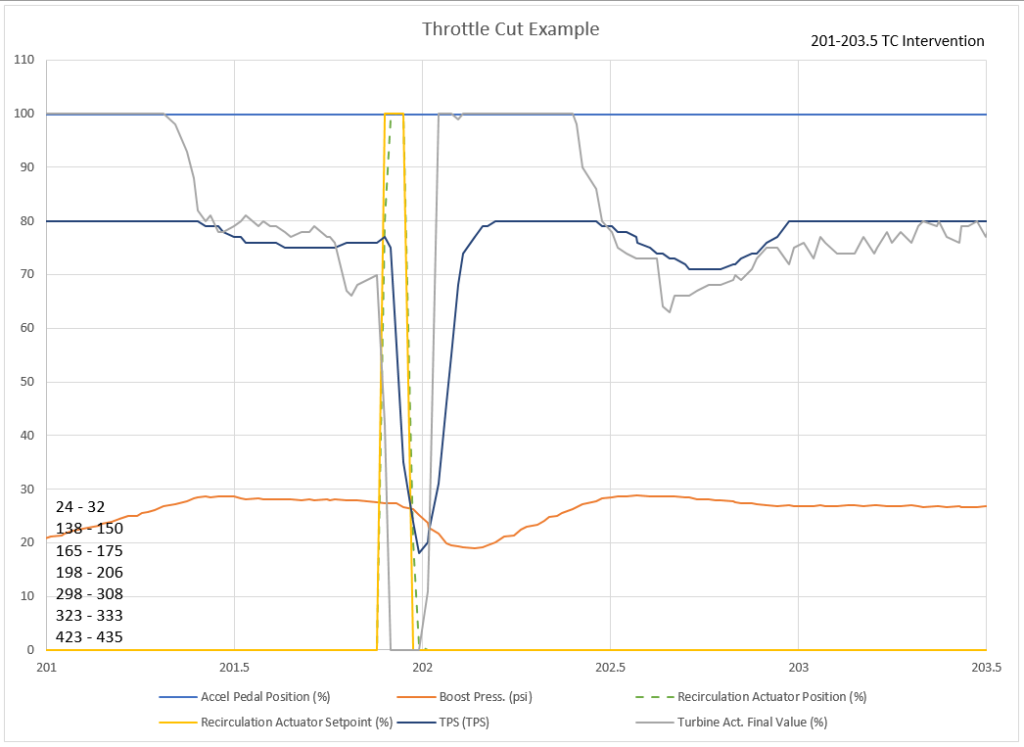
I did record some part throttle acceleration, but nothing abnormal came of it.
The issue evaluation status is now:
- Loss of power
- Loss of response
- Sacrificing pressure that just finished building (Disproven)
- Have to build up pressure after BOV closes (Disproven)
- DV loses almost no boost on shifts. (Disproven)
- BOV leads to sharper RPM drop off and boost drop at shifts (Disproven)
- Air-Fuel ratio “anomalies (Disproven)
- “STFT / LTFT “anomalies (Disproven)
- “Loss of acceleration
- Incorrect load targets (Disproven)
Of the three remaining claimed issues; loss of power, loss of response, loss of acceleration, it would be a fool’s game to spend more time gathering data to analyze. No evidence collected during this test supports further investigation of those claimed issues.
Additionally, #1 and #2 were provided by the enthusiast who stated “i don’t know shit to it just stating what others have said.“

There is misunderstanding among many enthusiasts about how a BOV and DV affect boost pressure. That misunderstanding has led to erroneous conclusions about how the products affect vehicle performance.
Final conclusions:
The diverter valve and blow-off valve perform the same function, releasing pressure from the charge pipes. This comparison has shown that the operating times and rates at which boost pressure decreases and increases is very similar for both products used in this comparison.
Maximum operating boost pressure for either product was not the subject of this test. The GTI used for testing boosts to 28 psi and holds approximately 26 psi to redline. There was no apparent difference in ability to hold this boost pressure between the stock DV and Forge BOV.
Reliability was not part of this assessment. The amount and type of information necessary to conduct a credible reliability study is far beyond what I have access to.
If you made it all the way through the content to here you can award yourself an “I survived the DV vs BOV post” badge.








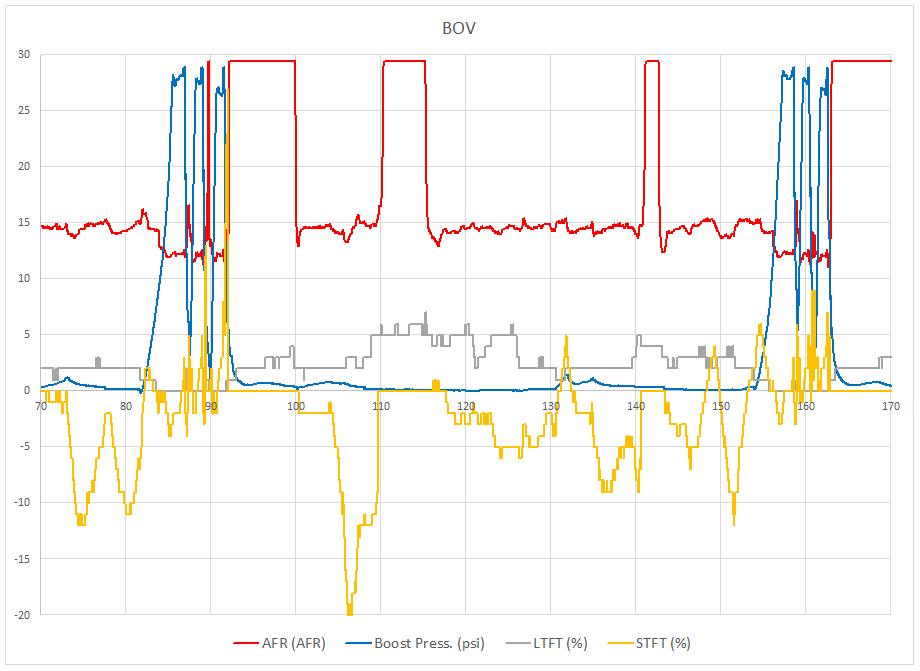
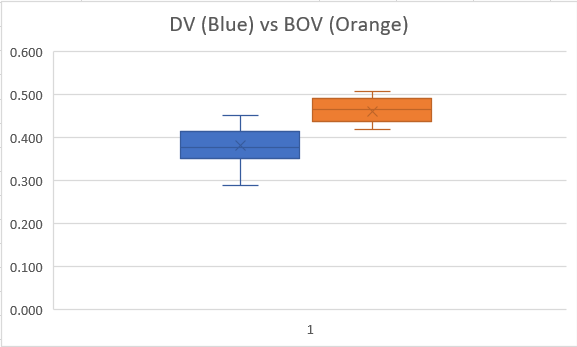
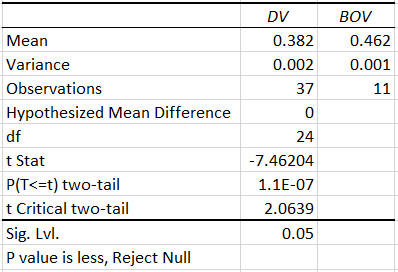
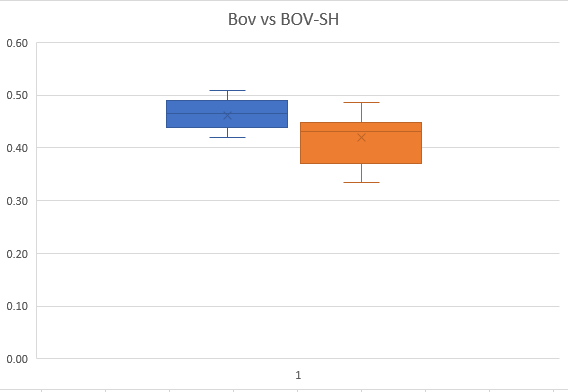


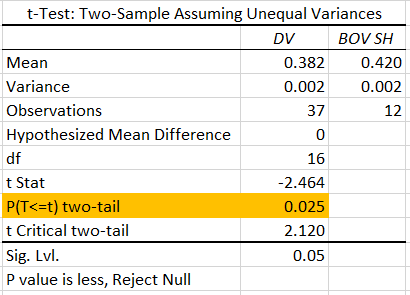

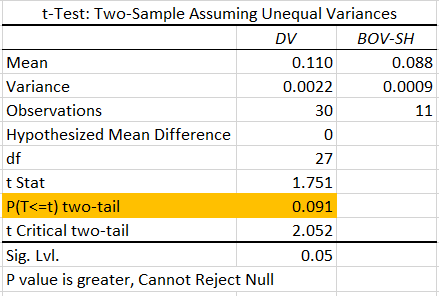
Thank you for the badge! I came across a video on gfb dv+ replacement out of Australia that looks interesting. My question though is what is the sound difference? This is my first turbo car and I like to hear it functioning a little more, do you hear much difference between stock and the forge bov?
Hey Luke, I use a closed intake so when I’ve swapped between the two bypass valve designs there is a difference in sound. Some people have said that with the right open intake there is a BOV like sound, which makes sense since the stock DV is also blowing off the pressure, just to the inside of the intake versus outside.
Thanks I find your site very helpful to choose the mods I’ve done so far. Will be going is38 on my sportwagen, but in the mean time I have done the stock intake mods along with TIP and a tune. I think I am going to try the new apr open intake which isn’t carbon fibre and has a much nicer price point. You haven’t specifically tested that one I don’t think but based on the design should be at least as efficient as modified stock and increase the noise.
Great article. I love the sarcasm in your posts. I’m not going to do a BOV right now because it’s not needed and it won’t make the car faster. I just like reading your articles and I appreciate the time and effort you put into them. Thanks…..
Hi, as a car nerd, i thoroughly enjoyed this post. Perhaps one thing to consider – is the EA888 MAP or MAF-controlled? Some time ago in a BMW publication, i read that the N54 and N55 reaxt differently to BoVs as the former is MAP-controlled (BoV-friendly) and the latter is MAF-controlled (not BoV-friendly).
The theory posited was exactly what you have also heard in the VW forums – “if your engine uses a MAF then you should not be using a blow-off valve as air that your MAF has already accounted for will be vented to atmosphere and your engine sim will end up running rich”
I’ll be interested to hear your thoughts on this!
-@thegeekauto
Hello, this engine uses a MAP sensor and does not have a MAF sensor. As you pointed out, if there were a MAF sensor that would change the situation considerably.
Misinformation? On “that” forum? U don’t say?
😂
I hardly post any replies but I’m always reading your articles and use them to make reasonable decisions when it comes to upgrading my R. I’m not looking to make new speed records but to get the most bang for my buck when it comes to enjoying what I drive. Thank you for all your efforts. They are truly appreciated.
Thanks for the feedback! I appreciate knowing that others are finding the information helpful.
“Maximum operating boost pressure for either product was not the subject of this test. The GTI used for testing boosts to 28 psi and holds approximately 26 psi to redline. There was no apparent difference in ability to hold this boost pressure between the stock DV and Forge BOV.”
Jeff, do you thing that the stock DV could handle for a good miles this kindle of pressure? I onde have citroen ds3, and DV spring after a while couldnt handle it… If the on from GTI could, i ll keep the stock one.
I have no information about how reliable the stock DV is when operating at that pressure. I don’t know. My guess is that it probably will last based on my observations of what other people say and not having a problem yet with using a stock DV on my car.